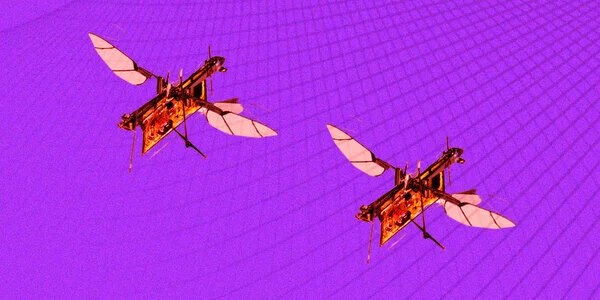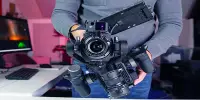Researchers were inspired by fireflies when developing soft actuators that can emit light in a variety of colors and patterns. These artificial muscles, which control the wings of featherweight flying robots, light up while the robot is in flight, providing a low-cost way to track the robots and possibly allowing them to communicate.
Fireflies that light up dark backyards on warm summer evenings use their luminescence to communicate: to attract a mate, ward off predators, or lure prey. These gleaming bugs also inspired scientists at MIT. Taking inspiration from nature, they created electroluminescent soft artificial muscles for flying, insect-scale robots. During flight, the tiny artificial muscles that control the wings of the robots emit colored light.
The robots could communicate with each other using electroluminescence. If a robot is sent on a search-and-rescue mission into a collapsed building, for example, it can use lights to signal others and call for help.
The ability to emit light also brings these microscale robots, which weigh no more than a paper clip, one step closer to flying independently outside of the lab. Because these robots are so light, they can’t carry sensors, so researchers must track them with bulky infrared cameras that don’t work well in the sun. They’ve now demonstrated that they can precisely track the robots using the light they emit and only three smartphone cameras.
We are extremely pleased with the tracking results when compared to the state-of-the-art. We were using inexpensive hardware in comparison to the tens of thousands of dollars that these large motion-tracking systems cost, and the tracking results were very close.
Kevin Chen
“If you think of large-scale robots, they can communicate using a lot of different tools — Bluetooth, wireless, all those sorts of things. But for a tiny, power-constrained robot, we are forced to think about new modes of communication. This is a major step toward flying these robots in outdoor environments where we don’t have a well-tuned, state-of-the-art motion tracking system,” says Kevin Chen, who is the D. Reid Weedon, Jr. Assistant Professor in the Department of Electrical Engineering and Computer Science (EECS), the head of the Soft and Micro Robotics Laboratory in the Research Laboratory of Electronics (RLE), and the senior author of the paper.
He and his collaborators accomplished this by embedding miniscule electroluminescent particles into the artificial muscles. The process adds just 2.5 percent more weight without impacting the flight performance of the robot.
A light-up actuator
Previously, the researchers demonstrated a new fabrication technique for creating soft actuators, or artificial muscles, that flap the robot’s wings. These long-lasting actuators are created by stacking ultrathin layers of elastomer and carbon nanotube electrode and then rolling it into a squishy cylinder. When you apply a voltage to that cylinder, the electrodes squeeze the elastomer and the mechanical strain flaps the wing.
The team incorporated electroluminescent zinc sulphate particles into the elastomer to create a glowing actuator, but they encountered several challenges along the way. To begin, the researchers needed to design an electrode that would not block light. They made it out of highly transparent carbon nanotubes that are only a few nanometers thick and allow light to pass through.
The zinc particles, on the other hand, only light up in the presence of a very strong and high-frequency electric field. This electric field excites the electrons in the zinc particles, which then emit photons, which are subatomic particles of light. The researchers use high voltage to create a strong electric field in the soft actuator, and then drive the robot at a high frequency, which enables the particles to light up brightly.

“Traditionally, electroluminescent materials are very energy expensive, but we get that electroluminescence for free because we simply use the electric field at the frequency required for flying. We don’t need new actuation, wires, or anything else. It only takes about 3% more energy to shine out light” Kevin Chen says
As they prototyped the actuator, they discovered that adding zinc particles reduced its quality, causing it to break down more easily. To get around this, Kim only mixed zinc particles into the top elastomer layer. He made that layer a few micrometers thicker to account for any decrease in output power. While this made the actuator 2.5 percent heavier, it emitted light without impacting flight performance.
“We put a lot of care into maintaining the quality of the elastomer layers between the electrodes. Adding these particles was almost like adding dust to our elastomer layer. It took many different approaches and a lot of testing, but we came up with a way to ensure the quality of the actuator,” Kim says.
The light color can be changed by adjusting the chemical combination of the zinc particles. Green, orange, and blue particles were created by the researchers for the actuators they created; each actuator shines a single solid color. They also changed the manufacturing process so that the actuators could emit multicolored and patterned light. The researchers applied a tiny mask to the top layer, then added zinc particles before curing the actuator. This process was repeated three times with different masks and colored particles to create a light pattern that spelled M-I-T.
Following the fireflies
They tested the mechanical properties of the actuators and measured the intensity of the light with a luminescence meter after fine-tuning the fabrication process. They then conducted flight tests with a specially designed motion-tracking system. Each electroluminescent actuator functioned as an active marker that could be tracked using the iPhone’s cameras. The cameras detect each color of light, and a computer program they created tracks the robots’ position and attitude to within 2 millimeters of state-of-the-art infrared motion capture systems.
“We are extremely pleased with the tracking results when compared to the state-of-the-art. We were using inexpensive hardware in comparison to the tens of thousands of dollars that these large motion-tracking systems cost, and the tracking results were very close” Kevin Chen claims
They intend to improve that motion tracking system in the future so that it can track robots in real-time. The team is working on incorporating control signals so that the robots can turn on and off their lights during flight and communicate more like real fireflies. According to Kevin Chen, they are also investigating how electroluminescence could improve some properties of these soft artificial muscles.
















